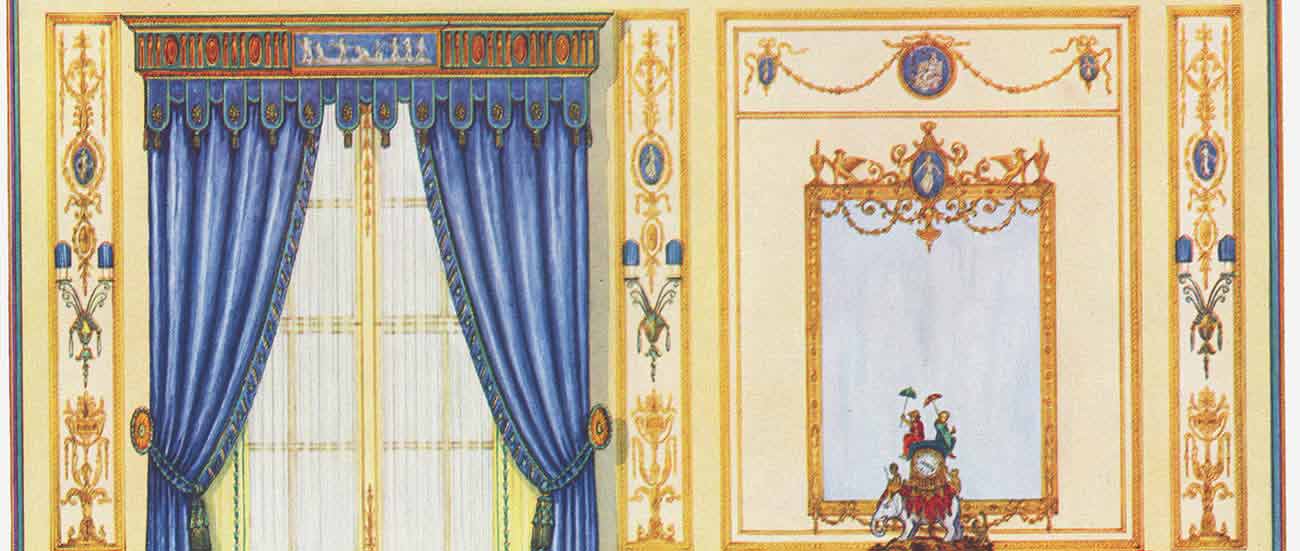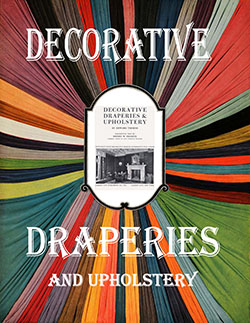This section aims to bring to your attention certain timeless fundamentals that will aid you in expressing your own good taste and at the same time show you how to make, in just the right way, the type of furnishings that please you personally and that harmonize in every way with your rooms and your furniture. The information is taken from Bernard C. Jakway's book "The principles of interior decoration" published in 1922.

Drapery Decorating from 1920-1939
WE ALL desire our homes to express good taste and to be attractive. Too often we accept substitutes or make compromises in our plans because of lack of information regarding essential details.
This section aims to bring to your attention certain fundamentals that will aid you in expressing your own good taste and at the same time show you how to make, in just the right way, the type of furnishings that please you personally and that harmonize in every way with your rooms and your furniture.
Methods approved by interior decorators are given here, as simply and clearly as possible, so that they may be followed easily. Remember that, in addition to correct construction, fashion, styles, the season, textures, colors, line, and design are all of almost equal importance. When you successfully bring these elements together, the result is certain to delight and satisfy you.
We have all recognized the growing importance of fashion as regards clothing and can readily see its significance as applied to home furnishings.
Styles and fashions in furniture and architecture have a definite influence on fabric furnishings. For example, with early American furniture, draperies must be in keeping with the simplicity and frugality characteristic of early American homes. Informal ruffled curtains, cretonnes and chintzes in the types and designs of that period, and even some of the very modern designs in the simpler fabrics, carry out the spirit of that age. Rooms done in the styles of the luxurious French periods require rich taffetas, brocades, silk,or voiles, and crisp organdies. On the other hand, ultra modern rooms tell us at once of the need of limp fabrics in plain colors, often in two tones, or in conventional designs, made with utter severity, while informal modern abodes speak just as definitely for unusual cretonnes and limp, neutral curtains, done in the most fashionable manner.
It is not enough to learn to make one kind of drapery or bed or chair cover. Variation in home appointments is an inspiration. Fashion provides change for us and it behooves us to be alert to those features of the new that are desirable. Valances may be plain one year, and ruffled, gathered, or box-plaited the next. Tie-backs have a way of moving up and down on the window frame or hiding away entirely. Ruffles come and go. We must be informed about what the accepted fashions are and then adapt our needs to keep in harmonious step with the new.
We realize, full well, that furniture should be selected a piece at a time, and with the greatest deliberation. Yet few of us have homes that have been furnished in this way. Our houses generally contain the things we have bought,—wisely or unwisely—gifts, and heirlooms, all of which we must try to place together with an aim for harmony and comfort.
When our rooms do not suit us, new furniture will seldom solve the problem, no matter how expensive it may be. If the house has not been built to our especial requirements, we encounter additional problems. For the solution we frequently look to fabric furnishings, expecting them to accomplish miracles in bringing the elements of a room together harmoniously.
Fabric furnishings may be made to produce the most amazing results. When we realize what paint can do in restoring furniture and then what fabric can do in giving crisp freshness and coziness to a room, we know that it is a matter only of intelligent interest and energy to make even the dullest, most inconsequential furniture and rooms take on a wholly new and satisfying appearance.
For gratifying results we must first adjust, arrange, and rearrange the furniture we have to a point of comfort and harmony. With this done, the vacant corner or the over-crowded corner will tell us what to put in or what to take out. When the walls and floors are taken care of and the furniture placed as effectively and as nearly correctly as possible, we should then begin deliberately to measure with a discerning eye and with discriminating good taste all the appointments and the entire arrangement, to see what improvements might be brought about—whether a doorway or wall space could be improved by the addition of hangings, whether a certain couch, chair, seat, or stool could be made more pleasing by the addition of a slip cover in a more suitable color or fabric, whether the windows could be improved by a distinctive set of curtains or draperies, whether the use of the right fabrics and colors would fulfill our desires.
Choosing Drapery Fabric >>>>Drapery Decorating | Choosing Drapery Fabric | House Draperies | Drapery Fabric | Drapery Designs and Textures | Buying Drapery Fabrics | Drapery Cleaning | Drapery FAQ | Antique Drapery Rods | Kirsch Drapery Rods | Theatrical Drapery | Theatre Curtains | Theatre Remodeling

